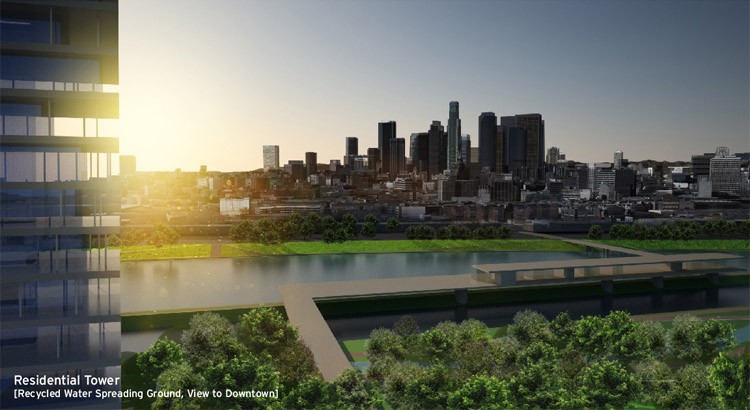Los Angeles Cleantech Corridor
2011The Cleantech Corridor offers not only a unique opportunity to be both the spatial and ideological center for regional Cleantech research and industry, but also an opportunity to become the needed geographic and socio-economic connector between currently disparate parts of the city. To achieve these goals, a paradigm shift in each of the following three areas is critical: water management, transportation and education.
Any proposal for future development in the city must address the issue of water and water management: On a daily basis Los Angeles imports hundreds of millions of gallons of water from the north and the east, in addition to depleting the Los Angeles aquifer. At the same time, only a fraction of valuable seasonable storm water is captured and hundreds of millions of gallons of treated and re-usable water are discharged into the ocean.
While storm water management is improving (and is addressed along other sections of the river), not enough attention is given to waste water management. Millions of gallons of water could be recovered daily for use in industry, agriculture, and to replenish the aquifer. Water recycling measures must be enacted to begin closing the loop of source and distribution.
Any proposal for future development in the city must address the issue of water and water management: On a daily basis Los Angeles imports hundreds of millions of gallons of water from the north and the east, in addition to depleting the Los Angeles aquifer. At the same time, only a fraction of valuable seasonable storm water is captured and hundreds of millions of gallons of treated and re-usable water are discharged into the ocean.
While storm water management is improving (and is addressed along other sections of the river), not enough attention is given to waste water management. Millions of gallons of water could be recovered daily for use in industry, agriculture, and to replenish the aquifer. Water recycling measures must be enacted to begin closing the loop of source and distribution.


Education is the central aspect of intelligent growth. Education - investment in people – is key to the development of green industries in Los Angeles, to the creation of higher-wage green-collar jobs and to the empowerment of local communities. The past educational model – the school as factory - is untenable. In conjunction with the decline of routine cognitive and manual work in manufacturing, the Cleantech Corridor offers a new educational paradigm based on lifelong learning.
A sustainable environment is a teacher for all members of the community. The Cleantech Corridor is suited to be an educational center within the city. Enormous opportunities are possible for synergetic partnerships by locating satellite institutes affiliated with regional, national and international colleges and universities throughout the corridor, and by linking these research facilities to Cleantech businesses and industries in various fields. These new work and education partnerships will transform the local community and the idea of the factory itself.
Above all, connections must be made to local teaching facilities at the high school level. New high school educational models call for smaller schools with specialized academic focus, and for community partnerships (with libraries, community meetings spaces, skill centers, and vocational schools), linking all levels of education.
The Cleantech Corridor is an opportunity to create a model water district at the Los Angeles River. More precisely, it allows a model waste water treatment facility and waste water spreading grounds to be placed visibly at the physical and theoretical center of the city.
Despite being located near various highways and railways, most of the Cleantech Corridor suffers from a lack of coverage by public transportation. A variety of transportation systems do exist, yet they are often disconnected in ways that are both confusing and unpractical. Coordinating these, making them visible, easy and convenient to use is key to greening the city. In addition to improving and expanding traditional types of private and public transportation, new smart transport modes (shared taxi, express minibus, one-way car rental, park and ride, bicycle and car sharing) are emerging. The successful interlinking of these existing and emerging systems into a multidimensional transport node at Union Station will create a central hub capable of connecting the center of the city with the surrounding areas. Beyond traditional public transport modes, the district is well-positioned to take advantage of emerging transport modes with flexible routes, on-demand scheduling that rely on technology to achieve full coverage of an area without the need for new physical infrastructure.
Despite being located near various highways and railways, most of the Cleantech Corridor suffers from a lack of coverage by public transportation. A variety of transportation systems do exist, yet they are often disconnected in ways that are both confusing and unpractical. Coordinating these, making them visible, easy and convenient to use is key to greening the city. In addition to improving and expanding traditional types of private and public transportation, new smart transport modes (shared taxi, express minibus, one-way car rental, park and ride, bicycle and car sharing) are emerging. The successful interlinking of these existing and emerging systems into a multidimensional transport node at Union Station will create a central hub capable of connecting the center of the city with the surrounding areas. Beyond traditional public transport modes, the district is well-positioned to take advantage of emerging transport modes with flexible routes, on-demand scheduling that rely on technology to achieve full coverage of an area without the need for new physical infrastructure.
